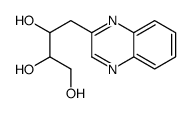2-(2',3',4'-Trihydroxybutyl)quinoxaline
Modify Date: 2025-08-25 17:53:01

2-(2',3',4'-Trihydroxybutyl)quinoxaline structure
|
Common Name | 2-(2',3',4'-Trihydroxybutyl)quinoxaline | ||
|---|---|---|---|---|
| CAS Number | 42015-38-3 | Molecular Weight | 234.25100 | |
| Density | N/A | Boiling Point | N/A | |
| Molecular Formula | C12H14N2O3 | Melting Point | N/A | |
| MSDS | N/A | Flash Point | N/A | |
Use of 2-(2',3',4'-Trihydroxybutyl)quinoxaline2-(2',3',4'-Trihydroxybutyl)quinoxaline is a food metabolite. 2-(2',3',4'-Trihydroxybutyl)quinoxaline can be formed from homoglucans[1]. |
| Name | 2-(2',3',4'-Trihydroxybutyl)quinoxaline |
|---|---|
| Synonym | More Synonyms |
| Description | 2-(2',3',4'-Trihydroxybutyl)quinoxaline is a food metabolite. 2-(2',3',4'-Trihydroxybutyl)quinoxaline can be formed from homoglucans[1]. |
|---|---|
| Related Catalog | |
| In Vitro | The 2-(2',3',4'-Trihydroxybutyl)quinoxaline (G-1) is formed from barley lichenan, and the approximate molar ratios of the 1,4- to 1,3-linkage in lichenan is estimated to be 2.2[1]. From scleroglucan, 2-(2',3',4'-Trihydroxybutyl)quinoxaline (G-1) is produced, reflecting a 1,3- and branched 1,6-linkage in the glucan[1]. |
| References |
| Molecular Formula | C12H14N2O3 |
|---|---|
| Molecular Weight | 234.25100 |
| Exact Mass | 234.10000 |
| PSA | 86.47000 |
| InChIKey | KFKHJQAEESRVHL-UHFFFAOYSA-N |
| SMILES | OCC(O)C(O)Cc1cnc2ccccc2n1 |
| 4-quinoxalin-2-ylbutane-1,2,3-triol |